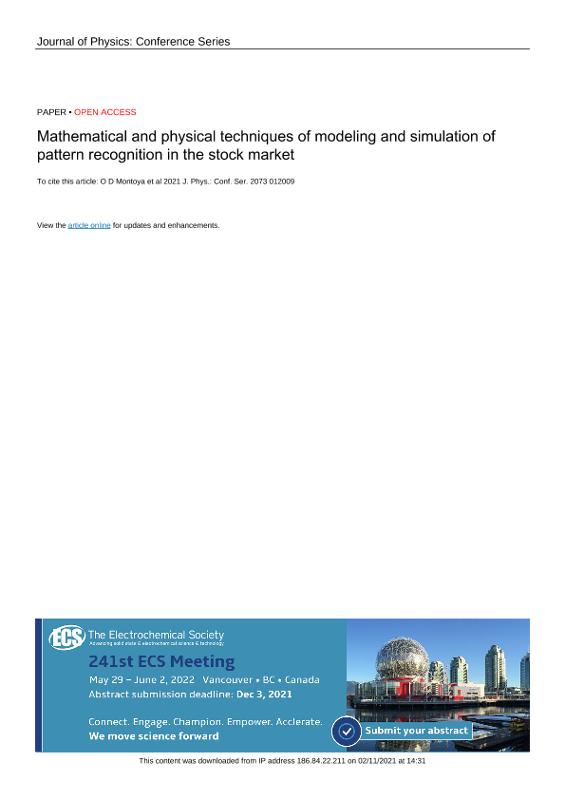Mostrar el registro sencillo del ítem
Mathematical and physical techniques of modeling and simulation of pattern recognition in the stock market
| dc.contributor.author | Montoya, Oscar Danilo | |
| dc.contributor.author | Narváez, D D | |
| dc.contributor.author | Ramírez Vanegas, C A | |
| dc.date.accessioned | 2022-02-03T15:06:17Z | |
| dc.date.available | 2022-02-03T15:06:17Z | |
| dc.date.issued | 2021-06-10 | |
| dc.date.submitted | 2022-02-02 | |
| dc.identifier.citation | Montoya Giraldo, Oscar & Narváez, D & Vanegas, C. (2021). Mathematical and physical techniques of modeling and simulation of pattern recognition in the stock market. Journal of Physics: Conference Series. 2073. 012009. 10.1088/1742-6596/2073/1/012009 | spa |
| dc.identifier.uri | https://hdl.handle.net/20.500.12585/10436 | |
| dc.description.abstract | The following article presents the analysis through mathematical and physical techniques of large databases, which are very common today, due to the large number of variables (especially in the information and physics industry) and the amount of information that results from a process, therefore an analysis is necessary that allows the Decision in a responsible manner, looking for scientific criteria that support said decisions, in our case a database of the forex system will be taken. Initially, a study and calculation of different measurements between the samples and their characteristics will be carried out to make a good prediction of the data and their behavior using different classification methods inspired by basic sciences. Below is an explanation of the techniques based on the analysis of data components and the correlations that exist between the variables, which is a technique widely used in physical processes to determine the correlations between variables. | spa |
| dc.format.extent | 8 Páginas | |
| dc.format.mimetype | application/pdf | spa |
| dc.language.iso | eng | spa |
| dc.rights.uri | http://creativecommons.org/licenses/by-nc-nd/4.0/ | * |
| dc.source | Journal of Physics: Conference Series, vol. 2073, (2021). | spa |
| dc.title | Mathematical and physical techniques of modeling and simulation of pattern recognition in the stock market | spa |
| dcterms.bibliographicCitation | García P, Sancho J L, Figueiras A 2010 Clasificación de patrones con datos faltantes: una revision Neural Comput. Appl. 19(2) 263 | spa |
| dcterms.bibliographicCitation | Bishop C M 1995 Neural Networks for Pattern Recognition (New York: Oxford University Press) | spa |
| dcterms.bibliographicCitation | Deng X, Liu Q, Deng Y, Mahadevan S 2016 An improved method to construct basic probability assignment based on the confusion matrix for classification problem Inf. Sci. 340 250 | spa |
| dcterms.bibliographicCitation | Rajendran S, Kaul A, Nath R, Arora A, Chauhan S 2014 Comparison of PCA and 2D-PCA on Indian faces International Conference on Signal Propagation and Computer Technology Technical (Ajmer: Institute of Electrical and Electronics Engineers) p 561 | spa |
| dcterms.bibliographicCitation | Gao Q, Sun S 2018 Speech recognition of confusable word based on ideal distance matrix IEEE/ACIS 17th International Conference on Computer and Information Science (Singapore: Institute of Electrical and Electronics Engineers) p 335 | spa |
| dcterms.bibliographicCitation | Xiang S, Nie F, Zhang C 2008 Learning a mahalanobis distance metric for data clustering and classification Pattern Recognition 41(12) 3600 | spa |
| dcterms.bibliographicCitation | Jing C, Hou J 2015 Enfoques de clasificación de fallas basados en SVM y PCA para procesos industriales complicados Neurocomputing 167 636 | spa |
| dcterms.bibliographicCitation | Rouabhia C, Hamdaoui K, Tebbikh H 2010 Weighted matrix distance metric for face images classification International Conference on Machine and Web Intelligence (Algeria: Institute of Electrical and Electronics Engineers) | spa |
| dcterms.bibliographicCitation | Koyuturk M, Grama A, Ramakrishnan N 2005 Compression, clustering, and pattern discovery in very highdimensional discrete-attribute data sets IEEE Transactions on Knowledge and Data Engineering 17(4) 447 | spa |
| dcterms.bibliographicCitation | Arya S, Mount D, Netanyahu N, Silverman R, Wu A 1998 An optimal algorithm for approximate nearest neighbor searching fixed dimensions Journal of the ACM 45(6) 891 | spa |
| dcterms.bibliographicCitation | Abello J, Korn A 2002 A system for visualizing massive multidigraph IEEE Trans. Visual Comput. Graphics 8(1) 21 | spa |
| dcterms.bibliographicCitation | Beringer J, Hüllermeier E 2006 Online clustering of parallel data streams Data Knowl. Eng. 58(2) 180 | spa |
| datacite.rights | http://purl.org/coar/access_right/c_abf2 | spa |
| oaire.version | http://purl.org/coar/version/c_ab4af688f83e57aa | spa |
| dc.type.driver | info:eu-repo/semantics/article | spa |
| dc.type.hasversion | info:eu-repo/semantics/restrictedAccess | spa |
| dc.identifier.doi | 10.1088/1742-6596/2073/1/012009 | |
| dc.subject.keywords | Mathematical techniques | spa |
| dc.subject.keywords | Physical of modeling | spa |
| dc.subject.keywords | Simulation of pattern recognition | spa |
| dc.rights.accessrights | info:eu-repo/semantics/openAccess | spa |
| dc.rights.cc | Attribution-NonCommercial-NoDerivatives 4.0 Internacional | * |
| dc.identifier.instname | Universidad Tecnológica de Bolívar | spa |
| dc.identifier.reponame | Repositorio Universidad Tecnológica de Bolívar | spa |
| dc.publisher.place | Cartagena de Indias | spa |
| dc.subject.armarc | LEMB | |
| dc.type.spa | http://purl.org/coar/resource_type/c_2df8fbb1 | spa |
| oaire.resourcetype | http://purl.org/coar/resource_type/c_2df8fbb1 | spa |
Ficheros en el ítem
Este ítem aparece en la(s) siguiente(s) colección(ones)
-
Productos de investigación [1453]
Universidad Tecnológica de Bolívar - 2017 Institución de Educación Superior sujeta a inspección y vigilancia por el Ministerio de Educación Nacional. Resolución No 961 del 26 de octubre de 1970 a través de la cual la Gobernación de Bolívar otorga la Personería Jurídica a la Universidad Tecnológica de Bolívar.













